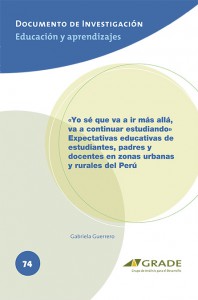“Yo sé que va a ir más allá, va a continuar estudiando” Expectativas educativas de estudiantes, padres y docentes en zonas urbanas y rurales del Perú
| Year | : | 2014 |
|---|---|---|
| Author/s | : | Gabriela Guerrero |
| Area/s | : | Education and learning |
Guerrero, G. (2014). “Yo sé que va a ir más allá, va a continuar estudiando” Expectativas educativas de estudiantes, padres y docentes en zonas urbanas y rurales del Perú (Documentos de Investigación, 74). Lima: GRADE; Niños del Milenio.
This study analyses the educational expectations of students, parents and teachers simultaneously in order to observe the congruence —or otherwise— between these expectations and their implications for students’ educational outcomes. In addition, due to the longitudinal nature of its data, it explores factors related to the formation of educational expectations at the beginning of secondary education and those linked to the realisation of these, if different.
In relation to the congruence between the educational expectations of the different actors, it is observed that there is quite a lot of overlap, especially between the expectations of parents and children. The educational expectations of both groups are high at the beginning of secondary education, as most of them, both in urban and rural areas, expect young people to reach higher education. It was also found that teachers’ expectations tend to be lower than those of parents and students; this is especially true in rural areas, as in urban areas the congruence between the expectations of the three actors is higher.
In general, the main conclusion from the analysis of the cases is that most of the risk-protection factors for the achievement of the students’ educational expectations are linked to the individual or family background —support from parents and siblings, availability of economic resources, etc.— of the young people, while factors more linked to the school or the teacher are practically irrelevant. Although it is understandable to a certain extent that in contexts of poverty such as that of the Young Lives sample, the individual and family factors are more important, the conspicuous absence of the educational institution should be a cause for concern, as it means that the school is not playing a role in levelling the playing field in favour of students from contexts of greater poverty.







